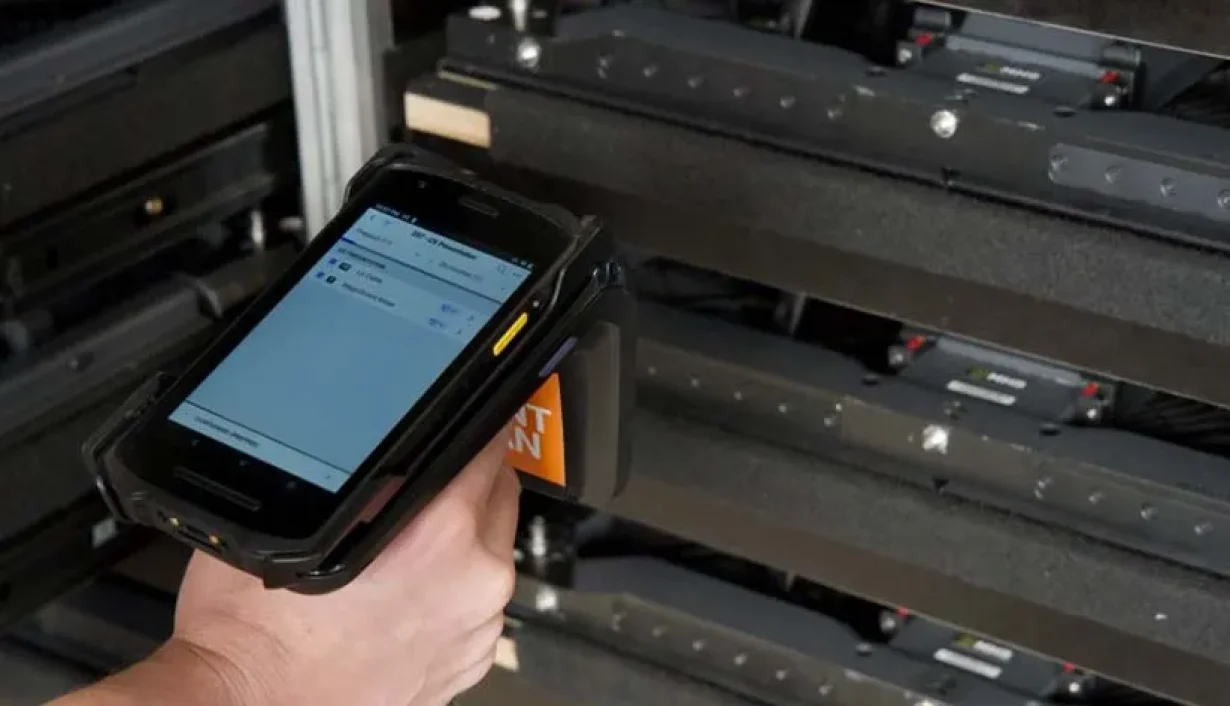
In today’s fast-paced business environment, efficiency is king. And when it comes to streamlining operations and boosting productivity, RFID (Radio Frequency Identification) readers are a game-changer. Think of them as the unsung heroes connecting RFID tags to your vital business data, enabling seamless data capture and real-time insights. These devices are the key to unlocking accurate data transmission and keeping your systems updated in real-time. For businesses aiming to enhance their RFID infrastructure or implement it for the first time, choosing the right RFID reader for purchase is a critical decision.
This guide is your deep dive into the world of RFID readers. We’ll explore the different types available, break down their technical specs, and give you the knowledge to confidently select the best RFID reader to meet your specific business challenges. Whether you’re just starting to explore RFID technology or looking to upgrade your current system, we’ve got the practical advice and insights you need to make smart, informed choices.
1. What Exactly is an RFID Reader?
At its core, an RFID reader is a fundamental part of any RFID system. It acts as the bridge for data exchange between RFID tags and your company’s information network. Using radio waves, these clever devices communicate with RFID tags, empowering organizations to efficiently track, monitor, and manage everything from assets and inventory to personnel.
Essentially, an RFID reader’s job is to grab the data stored on RFID tags and send it to the right system for processing. This data can be simple IDs or complex information, depending on the type of RFID tag in use.
You’ll find RFID readers making a difference across numerous industries, including retail, logistics, healthcare, and manufacturing. They make real-time data collection possible, dramatically cut down on human errors, and significantly boost how efficiently operations run.
Key Parts of an RFID Reader:
- Antenna: Think of this as the voice of the reader, sending and receiving signals to talk to RFID tags.
- Reader Module: This is the brain, processing the signals it gets and pulling out the important information stored on the tags.
- Interface: This is how the reader connects to the outside world – your systems – using connections like USB, Ethernet, or wireless.
RFID readers are engineered with a variety of designs and technical capabilities to suit diverse business needs. Understanding what an RFID reader does is the first step in choosing the right one for your organization’s RFID applications.
2. Exploring the Different Types of RFID Readers
The world of RFID readers for sale is diverse, with various types designed to fit specific business needs and work environments. Picking the right type is crucial for smooth operations, reliable data capture, and lasting performance. Let’s explore the main types:
2.1 Fixed RFID Readers
Fixed RFID readers are your stationary workhorses, typically installed in key spots like doorways, gates, or along production lines. They are built for high-volume, continuous scanning of RFID tags, making them perfect for situations where items need constant tracking or monitoring in a set location.
Key Features:
- Permanently set up for non-stop operation.
- Commonly found in warehouses, loading docks, and entry points.
- Often support multiple antennas for wider coverage areas.
Ideal for: Inventory control, asset tracking within facilities, and access management in fixed locations. Consider a fixed RFID reader purchase for these applications.
2.2 Handheld RFID Readers
Handheld RFID readers offer portability, allowing users to scan RFID tags on the move. They are essential in environments demanding mobility, such as warehouses, field service operations, or retail floors.
Key Features:
- Portable and powered by batteries for ultimate flexibility.
- Designed for easy, immediate scanning of individual items or assets.
- Often include a display and barcode scanner for extra functionality.
Ideal for: Cycle counts, asset audits, and field-based tasks requiring mobility. Explore handheld RFID reader options for these mobile needs.
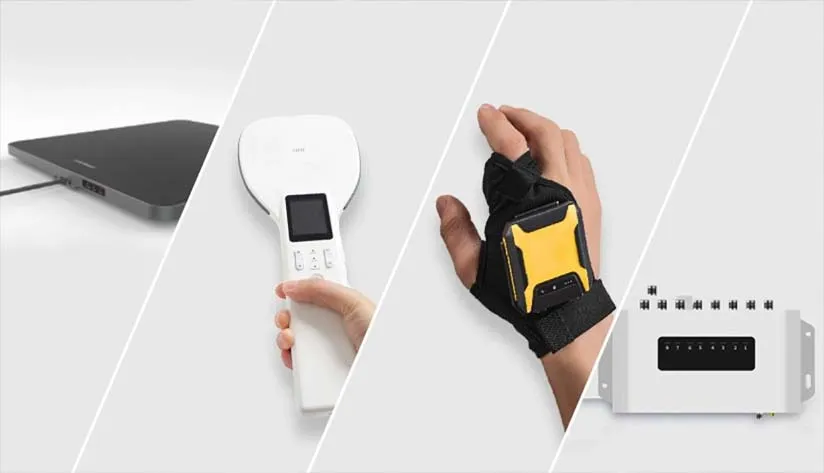
2.3 Wearable RFID Readers
Wearable RFID readers, such as wrist or glove-mounted devices, are designed for hands-free scanning in fast-paced settings. These readers excel in industries needing constant movement and tasks requiring high agility, like logistics, manufacturing, or retail.
Key Features:
- Lightweight and comfortable for all-day wear without fatigue.
- Hands-free operation boosts efficiency.
- Often integrate with mobile devices for instant data transfer.
Ideal for: High-throughput operations like order picking in warehouses or real-time asset monitoring in manufacturing. Consider wearable RFID reader solutions for efficiency gains.
2.4 Embedded RFID Readers
Embedded RFID readers are compact and designed to be integrated directly into equipment or machinery. This allows businesses to build RFID capability right into their systems. They are particularly valuable for automation and applications needing integration into larger systems.
Key Features:
- Small form factor for seamless integration into devices.
- Designed for automated, continuous scanning as part of larger systems.
- Frequently used in specialized equipment for automated processes.
Ideal for: Automated environments like conveyor systems, robotic arms, or vehicle tracking. Explore embedded RFID reader options for automation projects.
2.5 Desktop RFID Readers
Desktop RFID readers are small, convenient devices for low-volume scanning in controlled areas, like points of sale (POS) or service desks. They are user-friendly and perfect for scanning individual items or cards.
Key Features:
- Compact, portable, and simple to set up on any desk or counter.
- Used for scanning single tags or cards in retail or office environments.
- Often compatible with POS systems for smooth transactions.
Ideal for: Retail, ticketing, or customer ID applications where space is limited and scanning needs are low. A desktop RFID reader is a practical choice for these scenarios.
By understanding these different RFID reader types, businesses can make smarter choices to ensure their RFID system is both effective and economical. Choosing the right RFID reader is a key step towards optimizing your operations.
3. Decoding RFID Reader Technical Features and Key Metrics
Choosing an RFID reader wisely means understanding the technical details that matter. Here are the key features and metrics you should consider to ensure the reader aligns perfectly with your business needs:
3.1 Operating Frequency
RFID readers operate on different frequency bands, which directly impact their read range and how suitable they are for different applications. The common RFID frequencies include:
- Low Frequency (LF): 125 kHz, often used for access control and animal tags.
- High Frequency (HF): 13.56 MHz, widely used for access badges, payment systems like NFC payment readers, and ID cards.
- Ultra High Frequency (UHF): 860–960 MHz, ideal for long-distance scanning, inventory management, and logistics.
Key Considerations:
- Select the frequency based on your specific application and desired read range.
- Be aware of regional regulations for frequency use to ensure compliance.
3.2 Read Range
The read range is the maximum distance at which an RFID reader can reliably communicate with an RFID tag. This distance varies depending on the reader’s power, antenna design, and the RFID tag type.
- Short-range readers: Best for applications needing close proximity scanning (e.g., POS systems, NFC readers for payments).
- Long-range readers: Suitable for asset tracking and supply chain visibility, where tags may be read from a distance.
Key Considerations:
- Think about how read range affects your workflow (e.g., warehouse scanning versus door access).
- Match the read range to your actual needs to avoid unnecessary costs or performance issues.
3.3 Antenna Configuration
An RFID reader’s antenna setup greatly affects its performance. The antenna type determines how well the reader picks up signals from RFID tags.
- Single Antenna Configuration: A basic setup suitable for shorter range needs.
- Multiple Antennas Configuration: Provides broader coverage, ideal for large warehouses or multiple entry points.
Key Considerations:
- Assess the physical space and layout where the reader will operate.
- Multiple antennas offer flexible coverage but can increase system complexity and cost.
3.4 Communication Methods
RFID readers use various communication methods to transmit data to systems like computers or mobile devices. Understanding these options is key for smooth integration.
Wired Communication: RFID readers connect via cables like USB, Ethernet, or serial ports (RS232).
Best for: Stable, high-speed connections in fixed setups like warehouse management systems.
Wireless Communication: RFID readers connect wirelessly using Wi-Fi, Bluetooth, or cellular networks.
Best for: Mobile and remote applications such as inventory checks or logistics tracking.
Key Considerations:
- Choose wired readers for reliability and speed in controlled environments.
- Opt for wireless readers when mobility and remote access are needed.
3.5 Bluetooth Support
Bluetooth RFID readers are increasingly popular for their flexibility, allowing wireless communication with devices like smartphones and tablets – perfect for mobile operations.
- Bluetooth 2.0: Older, slower, and with limited range.
- Bluetooth 4.0 and newer: Faster, longer range, and energy-efficient, ideal for current RFID systems.
Key Considerations:
- Ensure the Bluetooth version meets your application’s needs (e.g., Bluetooth 5.0 for maximum range and speed).
- Consider power consumption, especially for battery-operated devices.
3.6 Protocol Support
RFID readers are designed to support specific communication protocols to ensure they work seamlessly with tags and systems. Common protocols include:
- ISO/IEC 14443: Used for contactless smart cards and RFID/NFC tags in access and payments.
- ISO/IEC 15693: Common in asset management and library solutions.
- EPCglobal Gen 2 (UHF): Standard for supply chain and logistics, offering long-range RFID capabilities.
Key Considerations:
- Verify the reader supports the necessary RFID standards for your tags and systems.
- Choose readers with adaptable protocol support for future scalability.
By carefully considering these technical features and key metrics, you can select an RFID reader that truly fits your business requirements, ensuring optimal performance and a strong return on investment. Understanding these specifications is essential when you buy RFID readers.
4. Step-by-Step: Choosing the Right RFID Reader for Your Business
Selecting the right RFID reader is crucial for maximizing efficiency and ensuring smooth operations. Follow this guide to make an informed decision based on your business needs:
4.1 Understand Your Business Requirements
Start by clearly defining your unique business needs. Consider these factors:
Business Scale and Application Scope:
- Small Business: For smaller operations, prioritize cost-effective, basic RFID readers. Handheld RFID readers or desktop RFID readers may suffice for inventory or access control.
- Large Business/Enterprise: Larger operations like logistics or manufacturing may need fixed RFID readers or industrial-grade options with long read ranges and multiple antenna support.
Use Case and Application:
- Determine if you’re using RFID for asset tracking, access control, supply chain management, or payment processing (potentially with NFC readers). Your primary use case will guide you in choosing necessary features like read range, speed, or mobility. Mobile retail applications might benefit from wireless or Bluetooth RFID readers, while warehouses may need fixed, long-range readers for automated tracking.
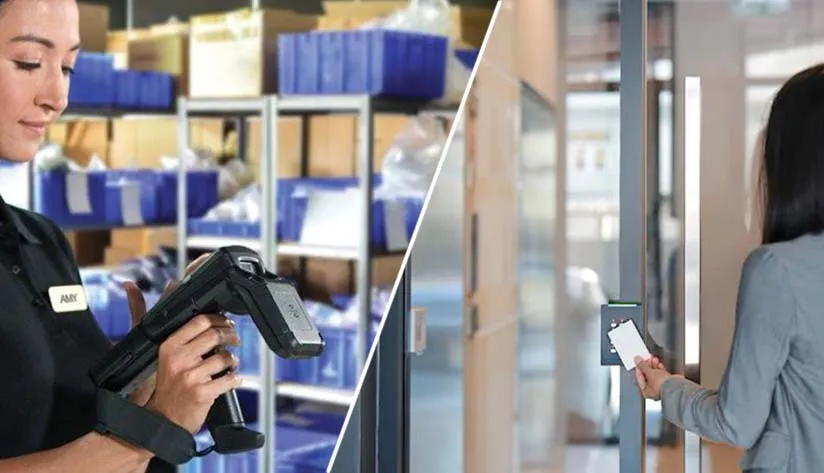
4.2 Evaluate Read Range and Speed
Read Range: Choose an RFID reader that matches your application’s required read range.
- Short-range applications: Readers with limited range (centimeters) may work for access control or POS systems.
- Long-range applications: For scanning tags at a distance (warehouses, supply chains), a UHF RFID reader with a longer read range (meters) is better.
Read Speed: For high-frequency reads (retail, inventory), choose a reader with high-speed scanning capabilities. Faster speeds improve efficiency in high-volume operations.
Key Considerations:
- Assess how often you need to read tags and the scanning area size.
- Select a reader range that fits your operational needs for efficiency without overspending.
4.3 Durability and Protection Rating
Durability is key, especially in harsh environments. Consider:
Waterproof and Dustproof Ratings (IP Rating):
- For outdoor or industrial use, look for IP65 or higher ratings for dust and water resistance, minimizing damage.
Shock and Impact Resistance:
- In environments where drops or impacts are likely (warehouses, retail), choose ruggedized models built to withstand tough conditions.
Key Considerations:
- Understand where your readers will be used. Prioritize durability for industrial or outdoor settings.
- Choose durable models without sacrificing performance or read capabilities.
4.4 Compatibility and Scalability
Ensure your RFID reader integrates smoothly with your existing systems for a seamless transition. Consider:
System Compatibility:
- Check if the reader works with your current software, hardware, and RFID tags. Some readers are optimized for specific systems (ERP, POS), so verify compatibility.
Future Expansion:
- Opt for readers with expansion features (multiple antenna ports, protocol support). This ensures your system can grow with your business, especially if you plan to scale your RFID deployment.
Key Considerations:
- Verify reader compatibility with your current tech and software.
- Choose scalable solutions to accommodate future needs, saving upgrade costs.
4.5 Budget and Cost Considerations
Budget is important, but balance cost with capabilities:
Initial Investment vs. Total Cost of Ownership:
- Cheaper readers may seem attractive but can lead to higher long-term costs due to maintenance or shorter lifespans. Consider warranty, support, and updates when calculating total ownership cost.
Cost vs. Performance:
- Decide if higher-end reader features (range, speed) are necessary. Premium features may not be worth the investment if not essential for your needs.
Key Considerations:
- Don’t only focus on upfront costs—consider long-term performance, support, and scalability.
- Evaluate total cost of ownership for the best value.
By following this process, you’ll be well-equipped to choose an RFID reader that meets your business needs, balancing performance, cost, and scalability. This approach ensures your RFID system delivers ongoing value as your business grows. Investing in the right RFID reader is a strategic move for long-term success.
5. Common Mistakes to Avoid When Choosing RFID Readers
It’s easy to make mistakes when selecting an RFID reader, leading to inefficiencies or unexpected costs. Let’s review common pitfalls and how to avoid them:
5.1 Focusing Only on Price
While budget is important, focusing solely on price can lead to hidden costs. Cheaper readers may have limited features, lack durability, and require more maintenance.
How to Avoid It: Evaluate the total cost of ownership, including maintenance and reliability, not just the purchase price.
5.2 Ignoring Compatibility
Choosing a reader that doesn’t integrate with your systems can cause disruptions and extra costs.
How to Avoid It: Ensure reader compatibility with your existing software, hardware, and RFID tags. Look for flexible interfaces for future upgrades.
5.3 Overlooking Specific Needs
Not all RFID readers are suitable for every application. The wrong choice can lead to underperformance or unnecessary features.
How to Avoid It: Select a reader based on your specific needs (handheld vs. fixed, read range, durability) to meet your operational requirements.
5.4 Not Considering Future Expansion
Choosing a reader without considering growth can limit your system’s scalability.
How to Avoid It: Opt for readers supporting multiple protocols and designed for scalability as your business expands.
5.5 Overlooking Durability
In harsh environments, readers without sufficient durability can fail frequently.
How to Avoid It: Choose ruggedized readers with higher IP ratings (IP65 or IP67) for challenging conditions.
By avoiding these mistakes, you’ll be better positioned to select an RFID reader that meets your needs and supports long-term efficiency. Careful selection is key to maximizing your RFID investment.
6. Explore Our Complete RFID Solutions for Your Business
In conclusion, choosing the right RFID reader is vital for optimizing business operations across retail, logistics, warehousing, and more. The variety of RFID reader types ensures tailored solutions to enhance processes, improve accuracy, and streamline data collection. Whether you need to buy handheld RFID readers or fixed RFID readers, the options are plentiful.
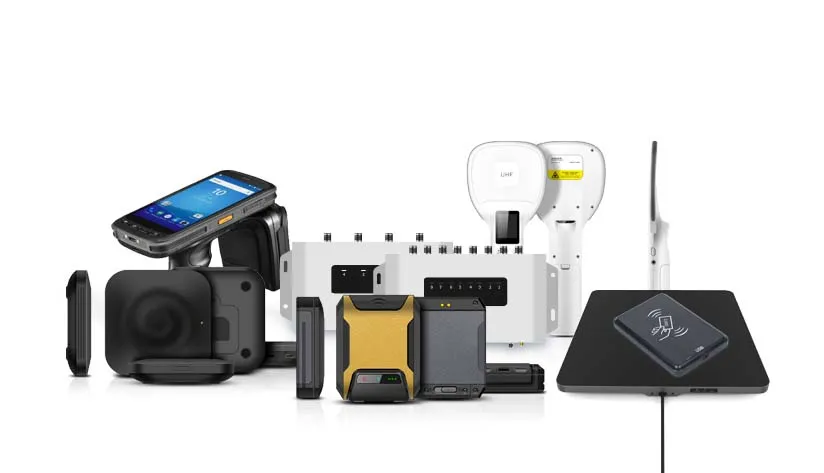
At our company, we offer a comprehensive range of RFID readers for diverse industries and applications. With over a decade of RFID technology experience, we provide the expertise to deliver optimal solutions for your business.
Our RFID readers are integral to complete RFID solutions, designed for seamless integration and scalability.
Ready to enhance your operations with reliable, high-performance RFID readers? Click here to explore our product range. Contact us today to find the perfect RFID solution for your needs!
FAQs
1 Can an RFID reader work with my existing POS system?
Yes, many modern RFID readers are compatible with POS systems. Check communication protocols (USB, Bluetooth, Ethernet) for integration. Our team can assist with compatibility checks.
2 Can handheld RFID readers be used in harsh environments?
Yes! Many handheld RFID readers are ruggedized with high IP ratings for water and dust resistance and shockproof enclosures, suitable for warehouses, logistics, and manufacturing.
3 What’s the typical read range of RFID readers?
Read range varies by reader type, frequency, and environment. UHF readers offer longer ranges (up to 12+ meters), while HF readers have shorter ranges (up to 1 meter). Choose a reader meeting your range requirements.
4 Are there any RFID readers that support Bluetooth communication?
Yes, we offer Bluetooth RFID readers ideal for mobile applications, connecting wirelessly to smartphones, tablets, and other Bluetooth devices.
5 How do I integrate an RFID reader into my system?
Integration involves connecting the reader to your hardware and software via wired (USB, Ethernet) or wireless (Bluetooth, Wi-Fi) connections. We offer support for smooth system integration.
Recommended Products
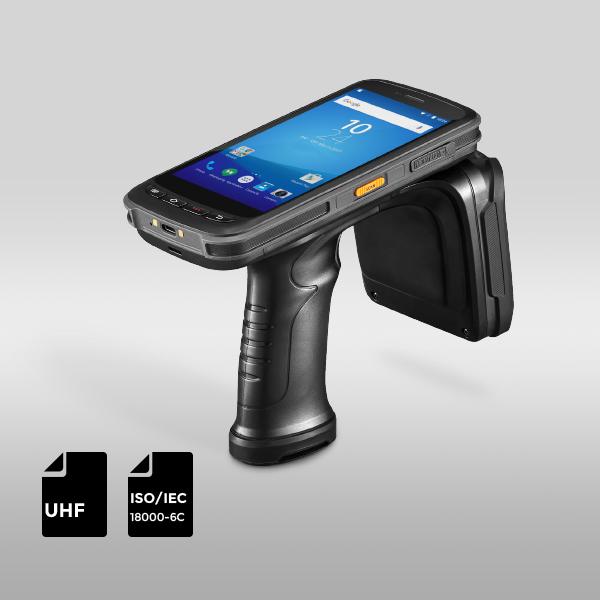
UHF RFID Handheld Reader | ISO 18000-6C
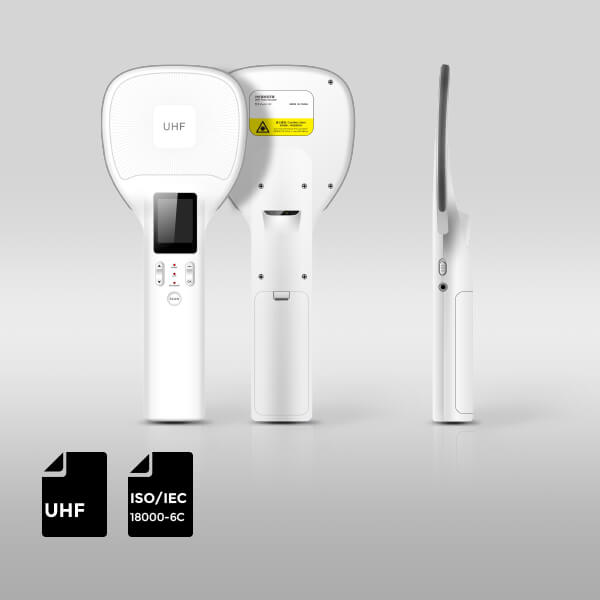

RFID Antenna UHF
15-Meter Cable for UHF RFID Fixed Reader
UHF Tag
4″x2″ 860-960MHz UHF RFID Label RFID M4D
UHF Tag
4″x4″UHF RFID Label Alien H3 | ISO18000-6C
RFID Antenna UHF
5-Meter Cable for UHF RFID Fixed Reader
HF Card
ABS RFID KEY-FOB Tag RFID Classic 1K
HF Card
ABS RFID KEY-FOB Tag RFID Classic 4K
HF Card
ABS RFID KEY-FOB Tag RFID Ultralight C
HF Tag
ABS RFID KEY-FOB Tag RFID Ultralight EV1
LF Card
ABS RFID KEY-FOB Tag ATA5577
LF Card
ABS RFID KEY-FOB Tag EM4200
HF Card
ABS RFID KEY-FOB Tag EM4305
HF Card
ABS RFID KEY-FOB Tag RFID TAG 213